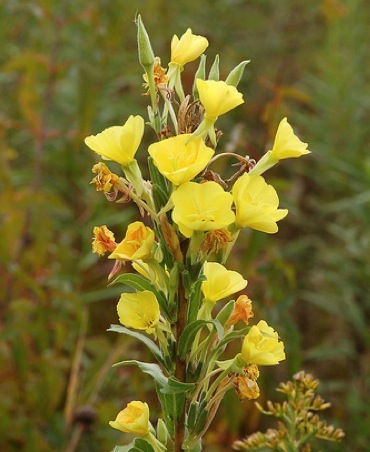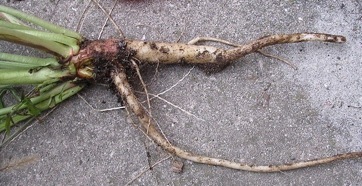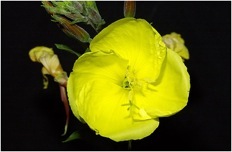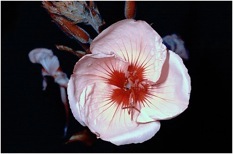Oenothera biennis: Foraging Standby
The Common Evening Primrose has long been a foraging standby and for a century or so was a common vegetable found in European gardens though it’s an American native….probably.
While the edibility of Oenothera biennis (ee-noh-THEER-uh bye-EN-niss) is not in doubt much about the plant is. Linnaeus, who started naming plants in the mid-1700’s, said it was introduced to Europe from North America in 1614. But some modern botanists say it’s native to Europe and went to North America with colonists. Curious: For a plant that might have been native to Europe it certainly was not utilized there until after its discovery in North America. By the 1880s, however, the Evening Primrose was a common garden vegetable in Germany.
The plant’s name also shrouded in a lexicographic fog. Oeno comes from the Greek word Oinos (said EE-nos which later went in to Latin and became vino. “Oi” in combination in Greek is always said “ee”.) Oinos means wine. Thera can mean catcher or hunter. So in polite circles it is interpreted as a root that can absorb wine. There is speculation that ancient (European) hunters would give some wine-soak root to animals to calm them down. I’m not sure that would work and might be a waste of good wine.
Pliny, 23-79 AD, had a different view of the word and wrote: “onothera, sive onear, hilaritatem afferens in vino” which translates into something like “ass catcher, a plant whose juice in wine causes happiness.” A 1601 translation read: “Oenothera, otherwise Onuris, an herb good also in wine to make the heart merry.” The famous botanist Merritt Fernald in 1950 gave up and said it means “wine scented.” Another interpretation is “wine imbibing.” Other views suggest it meant people believed the plant had ability to the calm ferocious man or beast. Biennis means two years, referring to the plant’s growth habit. Primrose means first rose, and since its blossoms open at night “evening” was added to common name a few centuries ago.
During the first year there is only a rosette of basal leaves. Then the second year the plant sends up a tall stalk with alternative leaves and yellow flowers at the top. The flowers open quickly in the evening and, depending on the weather, usually fade by mid morning. The root of the first year plant, cooked, is edible, usually late in the season. Raw it will irritate the throat. Young leaves from the second year stalk were cooked as greens by the Cherokee indians (who first saw Europeans in 1540.) Young second year stalks can also be peeled and eaten. That stalk dried makes a good drill for making fire. Leaves can be eaten if boiled more than once but they are usually tough and gritty. Flower buds can be eaten raw or cooked and the flowers added to salads. The seeds are edible as well (those seeds can also remain viable in the soil for at least 70 years.) Try all parts carefully and sparingly. They can bother the throat of some people even when cooked, and the taste may be acquired.
The young shoots of O. biennis, O. hookeri, and O. lamarckiana are edible raw. Roots of the O. hookeri have been eaten as well. The tough seedpods of the O. californica and O. nuttalli were eaten by the Indians as were the seeds of O. brevipes. O. fruticosa leaves were used as a potherb and it grows throughout eastern North America. Young crown leaves of O. biennis can be blanched and used for salads. People aren’t the only ones who appreciate the Evening Primrose. A lot of insects also like it as well and O. biennis has ultraviolet markings to help the bugs land.
O. biennis is found throughout North America except Idaho, Colorado, Utah, Arizona, and Wyoming.
Green Deane’s “Itemized” Plant Profile
IDENTIFICATION: Lemon-scented, large yellow flowers at the top of a leafy, hairy stalk, stalks, often purple-tinged, erect, 2-6 ft. with leafy, branched stems from a basal rosette. Four-petaled flowers to 2 inches across open at night, close in the day. Second year stalk has lance shaped leaves spiraling up the stem topped by flowers. Seed pod splits into four parts. There is great variability in the plant but it rarely branches.
TIME OF YEAR: Young leaves, flowers and buds, in season, roots near end of first year, second year stalks early in season
ENVIRONMENT: Fields, prairies, thickets, waste ground, disturbed sites, cultivated areas, roadsides, railroads
METHOD OF PREPARATION: Numerous: Roots cooked, usually boiled, peppery. Young shoots – raw or cooked, mucilaginous and peppery. Flowers sweet, used in salads or as a garnish. Young seed pods – cooked, often steamed. The plant also has many medicinal applications.





